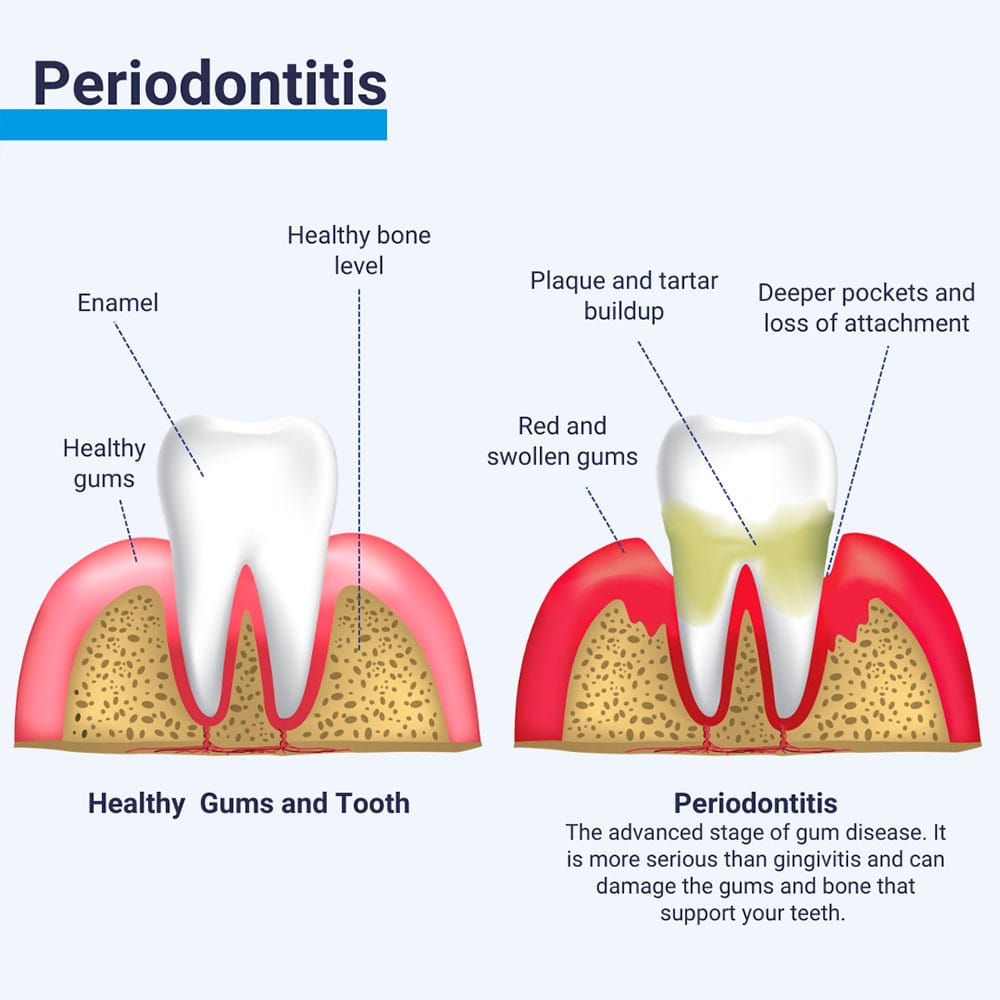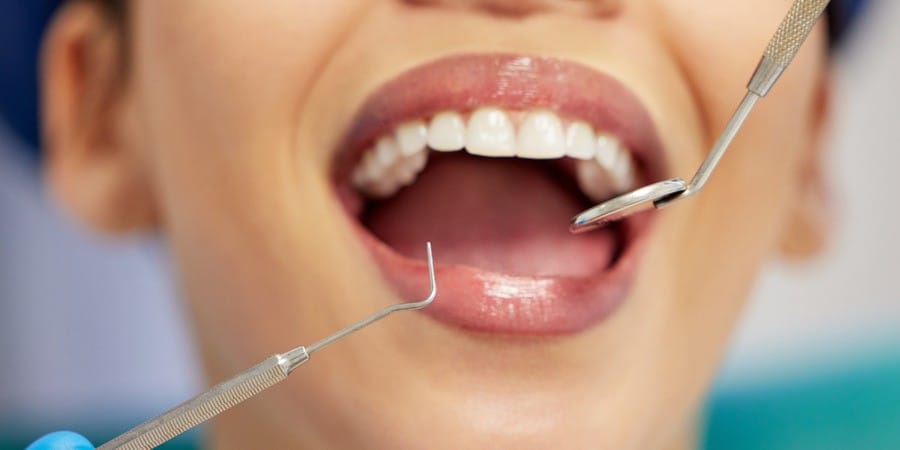What Is Periodontitis?
Periodontitis is a bacterial infection. It often occurs due to lax oral hygiene, where plaque and tartar (calculus) can build up over teeth.
Initially, plaque will cause gingivitis, which is a mild gum irritation and infection. Gingivitis is reversible with prompt dental treatment.
Unfortunately, periodontitis is a severe form of gum disease that can be incurable. However, it can be controlled with professional dental care from our periodontist, Dr. Richard Nejat.

How Does Periodontitis Develop?
Dental plaque is a sticky biofilm that mainly consists of bacteria. These bacteria thrive on the sugars and starches in food particles left trapped on and around your teeth. The bacteria produce toxins as a byproduct that infect and inflame your gums and other structures around your teeth.
Most plaque is removed through brushing and flossing but quickly returns as it continually forms. Any plaque that remains after brushing and flossing will harden into tartar. You cannot remove tartar by brushing and flossing as it requires a professional dental cleaning to get rid of it.
Both plaque and tartar contain harmful bacteria. The longer these substances remain on your teeth, the greater the damage.
What Are the Symptoms of Periodontitis?
When your gums are healthy they fit snugly around your teeth and are firm to touch. Healthy gums can range from a light pink to a darker pink or brown. If you have periodontitis, then the symptoms can include:
- Dark red or bright red gums or your gums may look a dark purple color.
- Gums that look puffy or feel swollen and are tender when lightly touched.
- Gums that are increasingly fragile and bleed easily.
- You may spit out blood after you brush and floss your teeth.
- Your toothbrush will look pink after you have brushed your teeth.
- Persistent bad breath.
- Pus buildup between your teeth and gums.
- Gaps between your teeth and gums, called periodontal pockets, as your gums start to recede and pull away from your teeth.
- Teeth can look longer as your tooth roots are exposed when gums recede.
- Gaps between your teeth are triangular and used to be filled with healthy gum tissue.
- Chewing may be painful.
- Teeth could fit together differently when you close your mouth.
- Teeth could feel loose or will drop out.
Who Is More Likely to Get Periodontitis?
Anyone can develop periodontitis, but some factors can increase your risk of this disease, which include:
- Already have gingivitis or mild gum disease
- A poor oral care routine
- Smoking or using any tobacco products or vaping
- A poor diet, especially if you don’t get enough vitamin C
- Hormonal changes, particularly during puberty, pregnancy, and menopause
- Taking certain medicines that can cause dry mouth or affect gum health
- Medical conditions that affect your immune system, like leukemia or cancer treatment
- Medical conditions like rheumatoid arthritis, diabetes, and Crohn’s disease.
- Obesity
What Are the Potential Complications of Periodontitis?
Periodontitis is a common cause of tooth loss but can also impact your overall health. The bacteria that cause this condition can enter your bloodstream through bleeding gums and potentially cause problems in other parts of your body.
Clinical studies have linked periodontitis with serious health problems like coronary artery disease, respiratory disease, and rheumatoid arthritis. It can cause problems during pregnancy, potentially leading to premature birth and low birthweight babies. People with diabetes and periodontitis can find it harder to control blood sugar levels.
How Is Periodontitis Diagnosed?
When you see a dentist, they can evaluate your gum health and determine if you have periodontitis and its severity. Below is what to expect during your dental exam.
Review Your Medical History
During your consultation, our dentist will review your medical history. This is to identify any risk factors for periodontal disease, such as taking certain medications or smoking.
Reviewing your medical history is an important part of any consultation to ensure any treatments we recommend are safe and appropriate.
Oral Examination
The dentist will examine your mouth to check for plaque and tartar buildup. They will also look to see if your gums bleed easily.
Measure the Depth of Any Periodontal Pockets
Advanced gum disease causes periodontal pockets to develop as your gums pull away from your teeth. Dentists measure the depth of these pockets using a periodontal probe. Healthy pocket depths are anywhere between one and 3 mm. If you have pocket depths in excess of 4 mm, you may have some form of gum disease. The deeper the periodontal pockets, the harder they are to keep clean.
Digital Dental X-Rays
Digital dental X-rays are useful as they will show our dentist if the infection has affected your jawbone. These images allow us to check for bone loss in areas with deeper periodontal pockets.
After completing your dental exam, our dentist can determine the degree of infection and the extent of the damage to your teeth and gums. A suitable treatment plan can then be created.
How Is Periodontitis Treated?
General dentists can provide some treatments for periodontitis, but if you have more severe gum disease, we suggest you see our periodontist, Dr. Richard Nejat.
Dr. Nejat has years of advanced training in treating periodontitis and can ensure you receive the most appropriate treatment to control this condition and help restore gum health. He may recommend a combination of nonsurgical and surgical procedures.
These procedures may include:
- Deep cleaning (scaling and root planing).
- Gum grafting.
- Bone grafting.
- Pinhole surgery.
- LANAP (laser dentistry).
Treatment will aim to thoroughly clean out the pockets around your teeth, preventing further damage to your gums and jawbone. It may be necessary to restore tissue significantly destroyed through gum and bone grafting.
Preventing Periodontitis
Gum disease is usually a preventable condition with the right oral care. It is one of the main reasons we strongly recommend patients visit us regularly for dental examinations and professional hygiene appointments.
We can monitor your gum health closely when you have regular dental exams. Hygiene appointments allow us to remove all plaque and tartar buildup regularly and are an easy and effective way to maintain strong and healthy gums.
Our hygiene team can also ensure you clean your teeth properly between visits. They have a wealth of useful information they can teach you and show you the best and easiest techniques for brushing and flossing thoroughly.
Have You Noticed Your Gums Bleeding?
If you are concerned about your gum health and would like a proper gum evaluation, please get in touch with Clock Tower Dental to schedule your dental visit with our friendly dental team.

